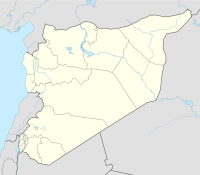Al-Kawm
| الكوم | |
| Location | Homs Governorate, Syria |
|---|---|
| Coordinates | 35°09′00″N 38°49′00″E / 35.15°N 38.81667°E |
| Type | Cluster of tells |
| Area | El Kowm I = 3 hectares (7.4 acres) |
| History | |
| Material | Flint, Bone |
| Founded | c. 7000 BC |
| Abandoned | c. 6500 BC |
| Periods | Paleolithic, PPNB, Neolithic |
| Cultures | Oldowan, Yabrudian, Hummalian, Mousterian |
| Site notes | |
| Excavation dates | 1967, 1978–1987, 1997– |
| Archaeologists | W.M. van Loon, R.H. Dornermann, D. Stordeur, J. Cauvin, M.C. Cauvin, L. Copeland, F.Hours, Jean Marie Le Tensorer, S. Muhesen |
| Condition | Ruins |
| Management | Directorate-General of Antiquities and Museums |
| Public access | Yes |
El Kowm or Al Kawm is a circular, 20 km (12 mi) gap in the Syrian mountains that houses a series of archaeological sites. The El Kowm oasis is located northeast of Palmyra in Syria, near Al-Sukhnah. It shows some of the longest and most important cultural sequences in the Middle East, with periods of occupation by humans for over 1 million years.
An initial 5-day sounding was made in 1967 by M.N. van Loon and R. H. Dornemann with a 3 by 50 metres (9.8 by 164.0 ft) trench at El Kowm I; a large Neolithic tell about 3 hectares (7.4 acres) in size. They categorised their findings into 5 periods; Early Neolithic (A), Middle Neolithic (B–C), Late Neolithic (D) and Post-Neolithic (E). Further excavations were made into a small outlying tell called El Kowm II by Danielle Stordeur between 1978 and 1987 by the French Ministry of Foreign Affairs permanent mission to El Kowm-Mureybet (Syria). The Neolithic stages at this smaller outlying tell showed one of the first places where domestic water and wastewater systems have been installed.
Further surveys and fieldwork were carried out from 1980 onwards by Jacques and M.-C. Cauvin, Lorraine Copeland, Francis Hours, Jean Marie Le Tensorer and S. Muhesen. Since 1989 further research has been carried out by the Institute for Prehistory and Archaeological Science of the University of Basel and the Department of History at the University of Damascus. These have concentrated on Paleolithic sites at El Kowm called Nadaouiyeh Aïn Askar, showing periods of inhabitation between 500,000 and 100,000 BP, and Hummal, showing evidence of human inhabitation of over 1 million years through the Oldowan and Hummalian blade industry periods. Another period was identified under the Yabrudian levels that has been tentatively named as Tayacian.
...
Wikipedia

